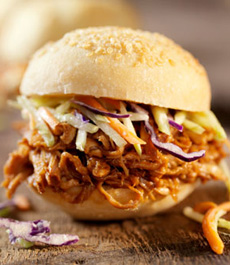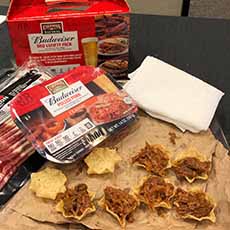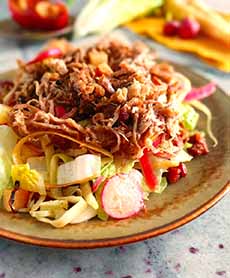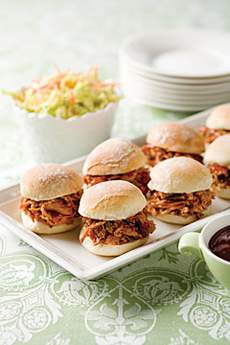TIP OF THE DAY: Coleman Natural Pulled Pork & Ways To Use Pulled Pork
|
For decades we knew Coleman Natural for its high quality, all natural beef. Today, the company focuses mostly on all-natural fresh and prepared pork products that are raised 100% Crate Free with no antibiotics ever, no added hormones or other growth promotants, and fed an all-vegetarian diet. Recently we were introduced to their pulled pork, made in the sweet Southern style with a barbecue sauce that includes Budweiser beer. It was served to us in tortilla chip cups (photo #2). The snack-or-appetizer is finger-licking good and simple to put on the table. Just spoon some pulled pork from the package (room temperature or warmed) into a platter of tortilla cups, and watch them disappear. Alternatively, you can serve the pulled pork on nachos, with the addition of cheese and a jalapeño slice. Or, you can set up a DIY appetizer stand and let people scoop their own, with their toppings of choice. All you need: We used the pulled in a number of ways, with various garnishes. One of the garnishes is a trio of toppings that we call “the fixings”: grated cheddar or jack, scallions, and sour cream Pulled pork is a preparation that originated in the South, where barbecued meats are a staple. It is made using barbecued pork shoulder (also called Boston butt, Boston shoulder, picnic shoulder, or pork butt). The shoulder is an inexpensive cut that becomes tender after a long period of cooking over low heat*. After emerging from the slow cooker, the meat is shredded (pulled) manually*, then mixed with a barbecue sauce, which can differ by region (see them here). The pork is often served on a roll, or on a plate with coleslaw. Fusion food: Carnitas, popular in Mexican cuisine, is pulled pork with different accents—beans, cilantro, and onions, with guacamole replacing the coleslaw. But first came this cultural event: Europeans were introduced to what we now call barbecued foods when Spanish explorers first arrived in Guyana around 1499. There they saw the Arawak natives building a smoky fire to smoke their game†. The Spanish, who brought pigs with them, used the process to smoke their meat. |
|
|
|
Later, as pork became a main meat for colonials in the Southern U.S., barbecue became a popular way to enjoy it. Here’s a longer history of pulled pork. ___________________ *Long, slow cooking softens the connective tissue in the meat, making it so tender that it almost falls apart before it needs to be pulled. †Our word “barbecue” comes from barbacoa, the Spanish adaptation of the word barabicu from the Taino people of Guyana (a related term is jerky, derived from the Quechua [Inca language] term charqui). Barabicu referred to a rack made of wood on which meat is roasted over flames from wood or charcoal. While drying meat is the oldest method of preserving it (e.g., jerky), a smoky fire kept the insects at bay, which further helped in the preservation of the meat. CHECK OUT WHAT’S HAPPENING ON OUR HOME PAGE, THENIBBLE.COM.
|
||







